Fortify Circulation & Lower Blood Pressure ... Easily
Blog Tag
Foods & Lifestyle Practices to Strengthen Circulation & Lower Blood Pressure... Naturally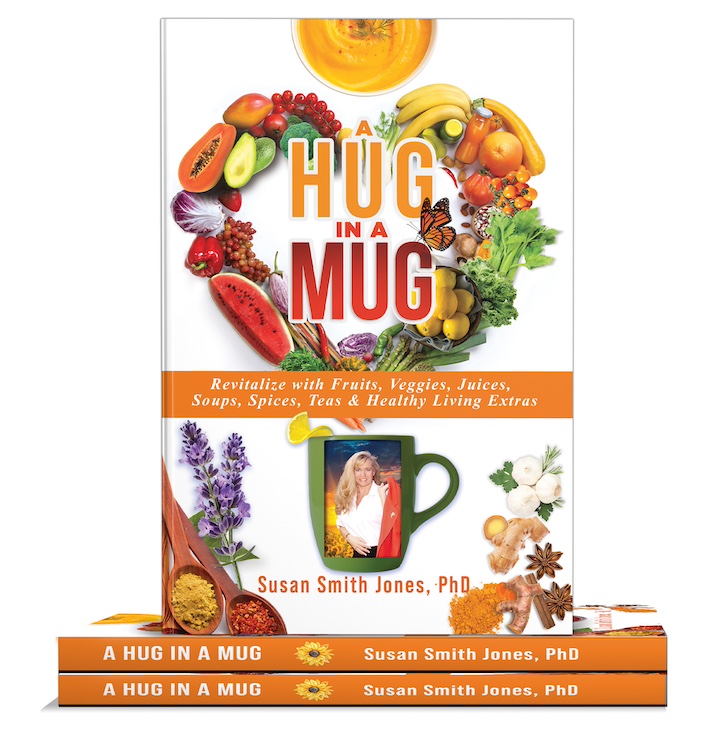
For simple ways to create a stressless lifestyle,
lower blood pressure and strengthen circulation, glow with vitality, soar with high self-esteem, exude enthusiasm, experience lasting joy, and savor life's simple pleasures, please refer to my book . . .
A HUG IN A MUG: Revitalize with Fruits, Veggies, Juices,
Soups, Spices, Teas & Healthy Living Extras
— Below are excerpts from an interview on This Week in America with host Ric Bratton. Together we discussed BLOOD CIRCULATION & NATURAL WAYS TO IMPROVE IT and we cover many topics, including nitric oxide, hypertension, libido, energy and the best natural foods and remedies to improve circulation, lower blood pressure and so much more ... that really work! To listen to this full interview, please click HERE.
 1. Susan, before we get into your natural remedies to help lower blood pressure, what is blood pressure and what are some of the risk factors?
1. Susan, before we get into your natural remedies to help lower blood pressure, what is blood pressure and what are some of the risk factors?
Blood pressure (BP) is the pressure of circulating blood on the walls of blood vessels. And it usually refers to the pressure in large arteries of the systemic circulation. Blood pressure is usually expressed in terms of the systolic pressure (maximum during one heart beat) over diastolic pressure (minimum in between two heart beats), and is measured in millimeters of mercury (mmHg). Normal resting blood pressure in an adult is approximately 120 millimeters of mercury for systolic, and 80 millimeters of mercury for diastolic, abbreviated "120/80 mmHg", and lately it has been revised down to 115/75. We should all know our numbers.
Risk factors for hypertension include physical inactivity, obesity, tobacco use, stress, and poor diet. Yet, conventionally trained doctors usually only offer a host of medications to control high blood pressure featuring serious side effects, which include weakness, headaches, swelling, flushing, and breathing difficulties.
2. Okay, are there safer ways to lower blood pressure? I did see on your website that you recommended Infrared Saunas to help with hypertension. Please explain.
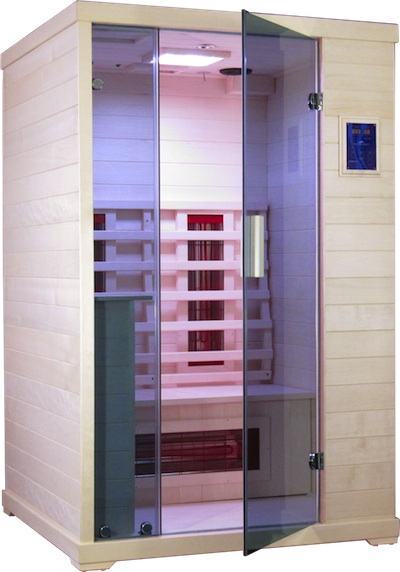 Blood pressure can often be lowered with lifestyle changes such as regular exercise, stress management and – most importantly – nutrition. You are the one who decides what you eat. No one, we hope, shoves the food into your mouth. With a few simple additions and tweaks in your diet, and changes in your lifestyle, you can see a profound difference in your blood pressure levels. The foods I’ll recommend can help you dramatically reduce your blood pressure – naturally. In fact, when used properly, they can equal the effects of blood pressure-lowering drugs. (Of course, you should never stop your prescribed medication without first discussing it with your doctor.)
Blood pressure can often be lowered with lifestyle changes such as regular exercise, stress management and – most importantly – nutrition. You are the one who decides what you eat. No one, we hope, shoves the food into your mouth. With a few simple additions and tweaks in your diet, and changes in your lifestyle, you can see a profound difference in your blood pressure levels. The foods I’ll recommend can help you dramatically reduce your blood pressure – naturally. In fact, when used properly, they can equal the effects of blood pressure-lowering drugs. (Of course, you should never stop your prescribed medication without first discussing it with your doctor.)
Infrared Sauna:
And yes, sitting in an Infrared Sauna will help lower blood pressure and soothe achy muscles, without a pharmaceutical assist: You don’t have to sit in an infrared sauna for hours on end to reap the benefits. For most people, all that’s needed is a few 15-20 minute sessions a week. During your sauna, as you sweat, you’ll be stimulating better blood flow and circulation throughout your body. That increased circulation will help lower blood pressure, and make you feel good all over, relaxing tight muscles and easing minor aches and pains to boot. If you’re troubled by muscle or joint pain, or more chronic conditions like arthritis, infrared heat from the sauna can provide drug-free pain relief, reducing stiffness and inflammation. In addition, it has also been shown to improve the functioning of the endothelial cells lining the arteries.
For more info on how Infrared Saunas support blood pressure, weight loss, a younger, healthy body, beautiful skin, detoxification and rejuvenation, and more, please refer to my book A HUG IN A MUG. Also, for more details on heat therapy, the benefits of sweating and relaxing in a sauna, and how infrared saunas prevent colds and the flu, click HERE.
For more info on the two Infrared Saunas I use and highly recommend — the Transcend Infrared Saunas, contact High Tech Health International, Inc. at: 800-794-5355 (within USA and Canada) or 303-413-8500, both MT, 8 - 4. They come in different sizes and shapes to fit in the tightest spaces in your home or office. Get a whopping $500 off your purchase when you mention my name (SSJ).
 LIMITED-TIME SPECIAL: Get $500 discount off a Transcend Infrared Sauna. Ask about their new Transcend Smart Sauna. It's simply wonderful!
LIMITED-TIME SPECIAL: Get $500 discount off a Transcend Infrared Sauna. Ask about their new Transcend Smart Sauna. It's simply wonderful!
The Transcend TR2 pictured above, designed for 2 people, is the one I use in my home — the best Infrared Sauna in the industry and it comes in a 1-, 2- or 3-person sauna to fit anywhere in your home or office.
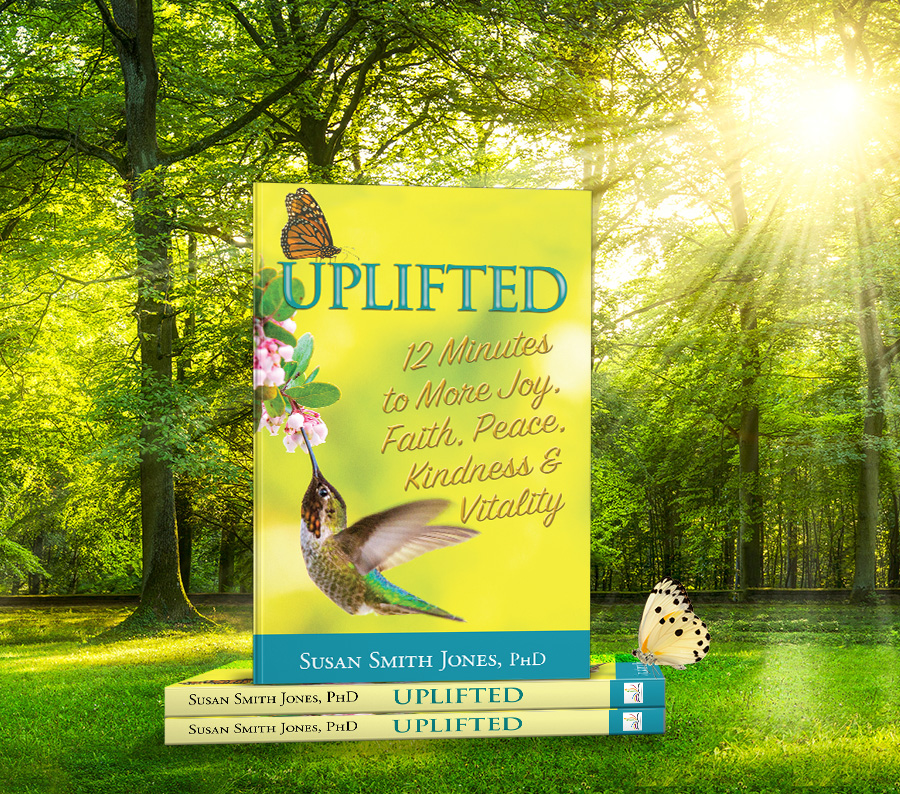 3. Now Susan, let’s get to some more exciting information… and discover nature’s most effective anti-hypertensive foods. Please go through your 9 favorite blood-pressure-lowering foods and then I’ll be eager to hear about your exercise tips. By the way, you can find all of this info in much more detail in her books UPLIFTED and A HUG IN A MUG.
3. Now Susan, let’s get to some more exciting information… and discover nature’s most effective anti-hypertensive foods. Please go through your 9 favorite blood-pressure-lowering foods and then I’ll be eager to hear about your exercise tips. By the way, you can find all of this info in much more detail in her books UPLIFTED and A HUG IN A MUG.
a. Cashews and Almonds
Both of these tree nuts are packed with magnesium, an essential mineral that plays a key role in supporting healthy blood pressure. Low magnesium levels are associated with high blood pressure, and ramping up magnesium intake can cause blood pressure measurements to be reduced.
A single cup of cashews and almonds gives you a hefty 360 milligrams of magnesium, right in the wheelhouse of the 310 to 420 milligrams per day ‘Recommended Daily Allowance’ advised by the Linus Pauling Institute. Here’s a bonus: eating almonds boost levels of serotonin, a “feel-good” neurotransmitter that may help ease the feelings of stress and anxiety that can contribute to hypertension. It’s so easy to drink almond and cashew milk, too. On my website, I give recipes on how to make these simple, delicious beverages.
 b. Beets
b. Beets
Also referred to as beetroot, this crimson root vegetable is loaded with nitrates and nitrites. Although many people are accustomed to thinking of these as dangerous, unnatural food preservatives, both occur naturally within the body. The key factor is which compound they convert to: carcinogenic nitrosamines are produced when nitrates are superheated – as in the case of fried bacon and cigarette smoke.
But when they are converted to beneficial nitric oxide, the result is blood vessels that are dilated and relaxed – resulting in lowered blood pressure. The effect can be dramatic. In fact, studies show that beetroot juice can reduce blood pressure by up to 10 mmHg (a millimeter of mercury is a manometric unit of pressure) within hours. And if 10 mmHg doesn’t seem very significant, remember, keep this in mind. A drop of only 5 mmHg can cause a 14% reduction in your chances of fatal stroke – very significant indeed.
Don’t forget to also eat the beet greens – rich in potassium to help normalize blood pressure.
 c. Turmeric
c. Turmeric
A bright yellow cooking spice commonly used in curries, turmeric gets its therapeutic powers from a potent antioxidant and anti-inflammatory compound called curcumin. Research has shown that supplementation with curcumin increases circulating nitric oxide – by as much as 40% in 4 weeks.
One clinical study showed that using 500 mgs of turmeric 3x times a day caused large blood pressure deceases in participants with inflammation of the kidneys. Because turmeric is not well absorbed by the body, I recommend taking it with black pepper to increase bioavailability.
d. Kale
Kale is something of a nutritional superstar these days, recommended by dietitians and physicians alike. And this green, leafy superfood is rich in not only magnesium, but also potassium – another essential contributor to  healthy blood pressure.
healthy blood pressure.
Interesting to note: Magnesium’s blood pressure-lowering effects are enhanced by potassium, causing these two minerals to become even more potent when ingested together.
Kale also contains hefty amounts of vitamin C, which boosts the effect of the two minerals even more. Because kale is rich in this triad of beneficial micronutrients, it has earned its place in the pantheon of natural hypertension fighters. Spinach has almost the same nutritional make-up as kale.
e. Fish and Flax Oil Fish oil is rich in omega-3 fatty acids, which benefit heart health. So it’s no surprise that fish oil supplementation is an effective natural treatment for high blood pressure. The primary reason behind fish oil’s power is its ideal balance of omega-3 and omega-6 fatty acid, as diets heavy in omega-6 fatty acids can be pro-inflammatory.
Fish oil is rich in omega-3 fatty acids, which benefit heart health. So it’s no surprise that fish oil supplementation is an effective natural treatment for high blood pressure. The primary reason behind fish oil’s power is its ideal balance of omega-3 and omega-6 fatty acid, as diets heavy in omega-6 fatty acids can be pro-inflammatory.
Unfortunately, many Americans’ diets leave them with lopsided ratios, skewing towards omega-6’s in an unhealthy proportion of 16 to 1. Reducing your ratio to 4:1 is linked with a 70% decrease in cardiovascular disease-related death. Eating more oily fish like salmon – while limiting intake of omega-6-laden vegetable oils — can help create balance, reduce inflammation, and lower blood pressure.
And if you eat a plant-based diet as I do, make sure to consume freshly ground flax seed meal, a cornucopia of omega-3’s — one to two tablespoons daily. As well, fresh, unfiltered, and unheated flax oil (as seen in the photo to the side) is an excellent addition to the diet. I often use it as the oil in my salad dressings, and also put a teaspoon or two into my smoothies. It is truly liquid gold and worth adding to a nutrient-rich diet.
f. Garlic The secret to garlic’s blood pressure-lowering abilities is its high content of allicin, a sulphur compound released whenever a garlic clove is chopped, crushed or chewed. In a recent study in a prestigious medical journal (Pakistan Journal of Pharmaceutical Sciences), researchers found that garlic, when consumed daily for six months, worked as well as a pharmaceutical medication to lower blood pressure.
The secret to garlic’s blood pressure-lowering abilities is its high content of allicin, a sulphur compound released whenever a garlic clove is chopped, crushed or chewed. In a recent study in a prestigious medical journal (Pakistan Journal of Pharmaceutical Sciences), researchers found that garlic, when consumed daily for six months, worked as well as a pharmaceutical medication to lower blood pressure.
Garlic is a boon to heart health but not to breath — to avoid offensive breath, I recommend drinking lemon juice or eating an apple and/or some parsley immediately afterwards.
g. Pomegranate
The flavorful scarlet-colored seeds and juice inside the fruit’s leathery-looking exterior are an excellent source of antioxidant polyphenols, including tannins, anthocyanins and ellagic acid. Researchers think these are the key to pom egranate’s ability to inhibit harmful LDL oxidation and treat hypertension.
egranate’s ability to inhibit harmful LDL oxidation and treat hypertension.
In a study published in Atherosclerosis, researchers found that consuming pomegranate juice could decrease the “stickiness” of blood platelets and lower blood pressure. In another study, participants with carotid artery blocks consumed pomegranate juice daily for 3 years – and experienced lowered blood pressure, along with a 30% decrease in atherosclerotic plaques.
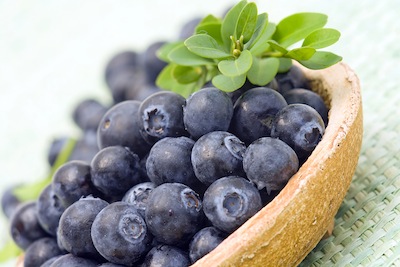 h. Blueberries
h. Blueberries
Forget that old apple-a-day adage—blueberries may be the real key to good health. Two recent studies suggest that this pint-sized superfood may even help lower blood pressure naturally. In a Journal of the Academy of Nutrition and Dietetics study, researchers found that after an 8-week period, postmenopausal women with high blood pressure who consumed a daily dose of freeze-fried blueberry powder (equivalent to 1 cup of fresh blueberries) experienced, on average, a 5% decrease in systolic blood pressure, a 6% decrease in diastolic blood pressure, and a 69% increase in blood levels of nitric oxide, which helps increase blood flow by widening blood vessels.
In a second study, mice on a high-fat diet supplemented with wild freeze-dried blueberries had significantly less inflammation and lower blood pressure than mice fed the same diet without the berries. (See the smoothie recipe below.)
 i. Green Tea & Hibiscus Tea
i. Green Tea & Hibiscus Tea
Green tea contains large amounts of catechins — polyphenols that support healthy blood pressure. In a meta-analysis of clinical studies published in 2014 in Scientific Reports, the authors credited green tea with causing significant reductions in blood pressure in participants with hypertension.
Like beetroot juice and curcumin, green tea increases the flow of nitric oxide, causing blood vessels to dilate and relax. A 2004 Chinese study published in The Archives of Internal Medicine and involving 1,507 men and women showed that drinking as little as 1/2 cup of green tea a day could lower risk of high blood pressure by close to 50%.
Hibiscus Tea is a delicious way to lower blood pressure and provide vitamin C. In a six-week study at Tufts University in Boston with people who had the highest blood pressure at the start, drinking three cups of hibiscus tea each day lowered blood pressure. In fact, it lowered systolic blood pressure — the top number in the blood pressure reading — by an average of 7 points. That was significantly more than the 1-point drop observed in people who were given a placebo in the form of hibiscus-flavored water. While a 7-point drop in blood pressure might not seem like much, keep in mind that even small changes in blood pressure — when maintained over time — will reduce the risk of stroke and heart attack.
I purchase my teas (and many other herbal products) from the stellar company Penn Herb Company.
4. This is all very encouraging Susan and I need to start a new grocery list and get these foods into my kitchen and body. Before we get to exercise, is there anything else we can do within our lifestyle to help lower blood pressure?
Sure. As mentioned previously, taking Infrared Saunas is very beneficial in lowering blood pressure and you can find several detailed articles about this salubrious Heat Therapy on my website. Also, it’s been scientifically proven that some kind of daily form of meditation is effective in reducing blood pressure. Of course, keep your body hydrated with ample purified, alkaline water daily, get plenty of sleep, adopt the habit of deep breathing, stay away from too much salt and junk foods, and get to/and keep a healthy weight for your body’s frame.
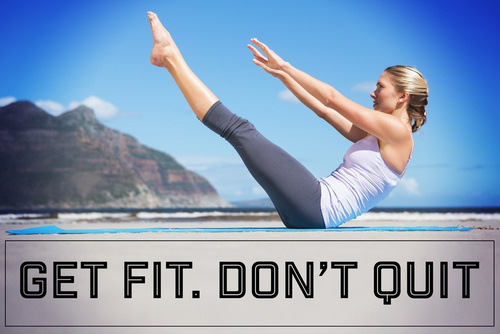 5. Great, now tell us about the best exercises to lower blood pressure.
5. Great, now tell us about the best exercises to lower blood pressure.
If you are inactive and lead a sedentary lifestyle, it will definitely contribute to higher blood pressure. So get in the habit of walking your dog every day, whether you have a dog or not. Exercise needs to be a non-negotiable habit, if you want to keep blood pressure in check and also be healthy, in general.
But there’s one specific exercise activity that I highly recommend and I have personally seen it reduce blood pressure in one of my clinical studies. It’s called Quiet- or Contemplative-Walking, Meditative-Walking, or even Prayer-Walking or Hiking. I’ve been doing these kinds of walks and hikes a few times a month for decades, and I learned about it from my grandmother when I was a teenager and was suffering from severe anxiety.
I have an entire chapter about this blood-pressure-lowering-exercise in my full-color, beautifully designed book Invest in Yourself with Exercise – highlighting why it works, how to do it, where are the best locations, when it’s most needed in our lives, and more.
This exercise improves health and well-being and nourishes the mind and soul at the same time. For those of you who are into multitasking and making good use of your oh-so-limited time, this concept of combining walking prayerfully or silently, or walking and meditation should be most appealing.
 6. How do you know Meditative-Walking helps lower blood pressure?
6. How do you know Meditative-Walking helps lower blood pressure?
I’ve done a few simple clinical studies all over the world in my holistic health retreats with countless people of all ages, both male and female. In a beautiful environment, we had participants test their blood pressure with a wrist monitor and write it down. We then had them do a Quiet-Walk as described in my book, usually between 20 – 60 minutes, and then they would test their blood pressure afterwards at about 5 minutes relaxation. For a majority of those participating in this simple clinical study over the years, and there have been over 300 people, blood pressure was lower after the Quiet-Walk. On one rare occasion it actually went up, and that was because a dog on the path scared the lady who was uncomfortable around dogs.
7. I know you cover this in detail in Invest in Yourself with Exercise, but briefly here, what does Quiet-Walking entail and how long do you need to walk to see benefits?
Most of us are busy talking all day long. Just 20 minutes of walking in silent meditation can slow down the mind, relax the body, and feed the soul. Besides, it’s a practical and efficient way to preclude overloading the daily schedule!
When I teach this kind of walking, I tell beginners to start with 20 minutes at least 3x a week. Make sure to walk fast enough to elevate your heart rate so that you will get a workout. Of course, if you’re not a beginner you can walk longer for more benefits. On days when, for whatever reason, you don’t feel like walking fast, it’s all right to go at a more leisurely pace. Start slowly to warm up, then a bit faster, and end with another slower pace to cool down.
 8. Where should one do a Quiet Walk?
8. Where should one do a Quiet Walk?
When I do Quiet-Walking, I select places in nature, whether in the mountains, by the ocean, in the desert, or at a botanical garden or local park – where there’s lots of natural beauty to surround me.
I try to find areas with the least noise and the fewest people, especially places where I won’t run into anyone I know. It can be very disconcerting, when you’ve been Quiet-Walking for 20 or 30 minutes and are deeply into your inner reflection, to hear someone call your name and come over for a chat. If that happens, politely say that you’re doing a special silent workout today and will be happy to give them a call later on. That usually works. If not, enjoy the encounter and then pick up where you left off, or try again another day.
9. Can I do Quiet-Walking with my wife or do I have to do it alone?
Absolutely you can do this with one or more people. I do these Quiet-Walks and Quiet-Hikes with others, but just have an agreement that during the walk or hike, you won’t be talking to one another and you can compare notes and thoughts together when it’s over.
10. What should I do during this walk?
By silently communing with what is around us, we can learn many things, and this is especially true when it comes to Quiet-Walking. Sometimes, instead of repeating an affirmation or a word like “STILLNESS,” saying silently “Still” with the inhalation, and “Ness” with the exhalation. I will simply stay in the present during the walk or hike, breathe deeply, and focus on and appreciate the beauty all around me.
11. Your description of Quiet-Walking makes it sound very simple and easy to do. Right?
Well, this is much harder to do than you might think. When I first started doing it, my mind seemed to wander every few seconds, like an untrained puppy, to every subject but the task at hand—appreciating the beauty of my surroundings. It took about a year, quiet-hiking 4-6 times monthly, for me to be able to do an entire 1- to 2-hour hike absorbed in nothing but the present and the beauty around me.
Like anything worth learning, Quiet-Walking or Hiking takes disciplined practice, but the effort has made a positive, profound difference in all areas of my life and for others I know who do this regularly. The physical and mental discipline brings spiritual discipline, and when all three are in harmony, all directed by the same desire and intention, you feel faith-filled, peaceful, balanced and empowered. I also think that it makes you look at the hard edges of your life and the world a little differently when you put your focus on the beauty around you, and on all for which you are grateful.
12. Thank you Susan, I will give this Quiet-Walking a try at the beautiful flower garden and park in my community. Is there anything else you’d like to mention before we conclude?
We can all choose to live with TRUE RADIANCE no matter our age and to age gracefully, healthfully, peacefully, and happily. It's usually a matter of making good choices day in, day out, finding reasons to celebrate your life, cultivating an attitute of gratitude, and include the foods and other lifestyle practices shared here today. For more information on how to do this, please click HERE.
Hidden-Spinach Berry Smoothie (Recipe from Wired for High-Level Wellness)
 Start your day with a big spinach salad? You will enjoy a salad's worth of healthy spinach in this luscious smoothie, and hardly notice it's there. Try freezing your own local berries when they are in season to use in smoothies all year long. When bananas start getting soft, just peel them, pop them in a freezer bag, and freeze to use in smoothies. Using frozen berries and bananas will give you a thick, almost ice-cream texture, and you may need to add a little milk to help it blend.
Start your day with a big spinach salad? You will enjoy a salad's worth of healthy spinach in this luscious smoothie, and hardly notice it's there. Try freezing your own local berries when they are in season to use in smoothies all year long. When bananas start getting soft, just peel them, pop them in a freezer bag, and freeze to use in smoothies. Using frozen berries and bananas will give you a thick, almost ice-cream texture, and you may need to add a little milk to help it blend.
In addition to antioxidants, this blend is loaded with blood-pressure lowering potassium, probiotics, and dietary nitrate. Sip some at breakfast and save the rest for an afternoon snack.
Total Time: 10 minutes
Servings: 3
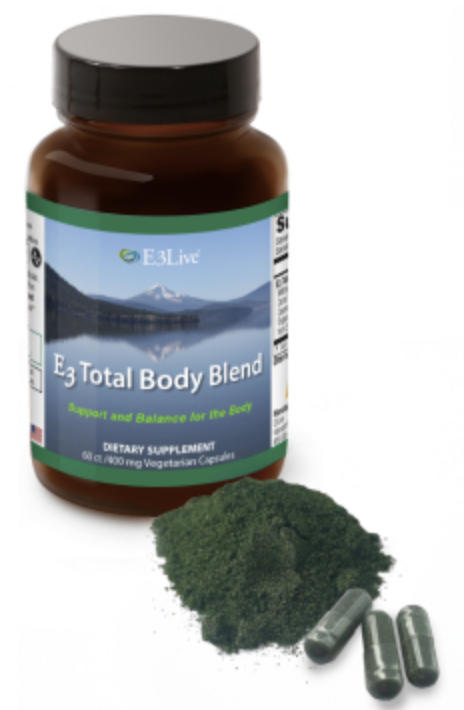 Ingredients
Ingredients
2 cups (8 ounces) frozen or fresh blueberries, raspberries, strawberries, or a mix
3 cups (3 ounces) spinach (packed) and/or kale
1 cup yogurt, kefir, or a non-dairy alternative like almond or cashew milk
1 large banana, fresh or frozen
1/8 teaspoon of Blue Majik powder and/or Total Body Blend powder (To increase the nutritional value, I use both of these powders together in most of my smoothies.)
Preparation
Put the berries and spinach in the blender first, and add the yogurt, banana and powder. Process, scraping down as needed. Blend until smooth and serve. I also throw in a quarter of a beet, a sprinkling of turmeric powder, and a teaspoon of flax seed oil.
Nutritional Information
247 calories, 2 g. fat, 5 mg. cholesterol, 157 mg. sodium, 52 g. carbohydrate, 8 g. fiber, 8 g. protein (If you use non-dairy products as I do, there won’t be any cholesterol.)


